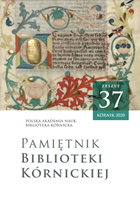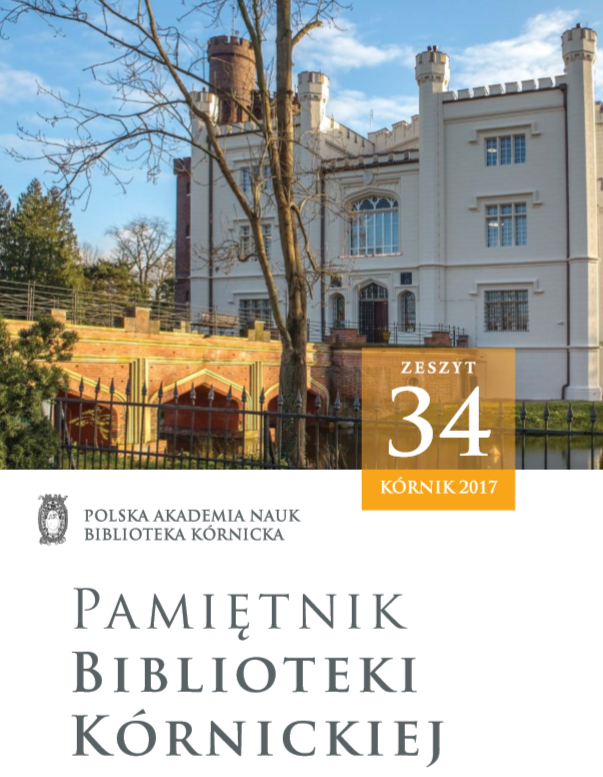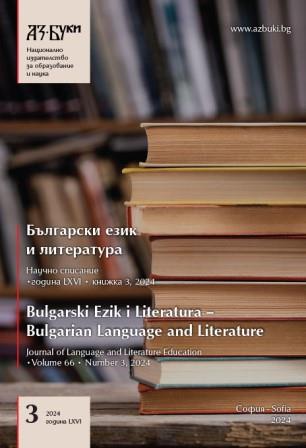
We kindly inform you that, as long as the subject affiliation of our 300.000+ articles is in progress, you might get unsufficient or no results on your third level or second level search. In this case, please broaden your search criteria.


The paper proposes several approaches for extending the possibility to write Medieval Slavonic Cyrillic and Glagolitic letters in GNU/Linux environment. This is achived by extension of existing keyboard layout, inclusion of newly defined Glagolitic one and by adding more combinations of keys through the multi key (compose key) technique. The proposal is tested and works in openSUSE GNU/LINUX distributions versions 11.3 through 13.2, the rolling release version Tumbleweed with KDE4, Plasma 5 and GNOME desktop environments.
More...
Ms. Sl. 156 (RA156) is an extensive Pentecostal Panegyric which includes texts from Holy Week through the Sunday of All Saints. The manuscript is incomplete, but its largest lacuna has been filled up from a miscellany of fragments in the collection of P. A. Shchukin, the State Historical Museum in Moscow. The fifth fragment of Shchuk 369 (Shchuk 369/V), located on Fol. 56r-68v according to the general foliation of the textual body, comprises folia that have been extracted from two different parts of a single jer manuscript. The first group of texts is related to Thomas Sunday (10 fol.), the second to Ascension (3 fol.). The manuscript dates from the 1320s-1330s. It has no jers and was written on Mt. Athos, then evidently transported to Romania by Paisii Velichkovski. This codex reveals a notable correlation between the orthography and the arrangement of the texts within each cycle of feasts, which sets it apart from other known South Slavic panegyrica and suggests that there could have been more than one protograph of the Pentecostal Panegyric.
More...
Artykuł Katarzyny Janickiej ukazał się niemal równocześnie z drugim, poszerzonym wydaniem mojej monografi i pt. Zamek w Kórniku z 1998 roku (dalej cyt. RK Mon. 1 i RK Mon. 2). Wbrew tytułowi artykułu Janicka nie przedstawiła propozycji rekonstrukcji zamku Stanisława Górki, ale własną wizję kórnickiej rezydencji Górki w II poł. XVI wieku, która mimo że nie została oparta na nieznanych dotąd przekazach materialnych czy historycznych, podana została jako ustalenia niepodlegające dyskusji. Podstawę owej wizji stanowi całkowite zanegowanie przez Janicką przedstawionej przeze mnie historii kórnickiego zamku w XV–XVIII wieku. Dość chaotyczna narracja artykułu, wykazująca przy tym braki podstawowego warsztatu badacza architektury, nierzetelne przytaczanie ustaleń przywoływanych autorów oraz pomijanie niewygodnych dla postawionej tezy faktów czy źródeł zmuszają mnie – jako autorkę monografi i zamku – do ich inkryminacji. Najistotniejsze kwestie omówię, przytaczając fragmenty artykułu Janickiej in extenso.
More...
The present essay is a recapitulation and revision of the author’s research conducted on the Digestum vetus kept by the Kórnik Library of the Polish Academy of Sciences (Ms. 824) over the last fifteen years. It focuses mainly on the 230 illustrations in the manuscript’s margins and explores the ways they interpret the text and facilitate its understanding. The Kórnik Digest was copied in Northern Italy in the late twelfth century or around 1200, but it was illustrated possibly in Paris, in the 2nd quarter of the thirteenth century, with historiated initials and marginal images. At the same time, an early version of Accursius’s Glossa ordinaria was also copied. Sometime in the 1470s, the book was brought to Poland by Dziersław of Karnice, a papal collector and a canon of Płock and Cracow. The marginal images in BK 824 were made by professional illuminators, but they are consistent with the concept and function of the earlier relatively widespread practice of the marking of Roman law manuscripts with text-related drawings. The locations of the images, often shared with other manuscripts of the Digest, and their iconography, give us some insight into the common interests of medieval jurists. On the other hand, the marginal illustrations, which play the role of visual annotations, introduce a subject-based indexation of the text and sometimes also cross-references, allowing us to better understand medieval reading techniques.
More...

The paper analyzes how the Byzantine law influenced The Town Law of Novo Brdo, which represents the second part of Despot Stefan Lazarević’s Novo Brdo Legal Code of 1412. A possible connection between the town law of Novo Brdo and certain provisions of The Syntagma of Matthew Blastares and one of the privileges that the town of Ioannina received from the Byzantine Emperor Andronikos II in 1319 is suggested. Accordingly, it is assumed that certain provisions of the Town Law of Novo Brdo could have been formulated during the reign of Emperor Stefan Dušan.
More...
The study is dedicated to the Legacy Collection of composers maintained by the Institute of Musicology of SASA. Due attention is paid to the history of its formation as well as to its unique contents which refers to the primary and very important archive sources related to the Serbian musical history. The text also provides a discourse which highlights issues concerning the strategies and perspectives of Serbian musicology. The Supplement gives a short description of each composer’s legacy.
More...
Constantin Anghelescu was a complex personality of the Interwar period, who was especially noticed for his tact and perseverance, which helped him to unify and modernize the Romanian educational system after the Unification of 1918. His higher education in Paris provided him a high-class training in the field of Medicine, as his activity as university professor represented a guarantee for the education of the future physicians. Also, The professionalism he provided in the field of politics also recommended him as a model for the future generations. As Minister of the Public Instruction in the liberal governments between the two world wars, Constantin Anghelescu started a wide campaign of building locations for primary schools, which generated occasions for work visits in which he assessed the progress of the construction works and inaugurated new education buildings. Thereby, we can explain the visit of the famous surgeon and politician in Târgu-Neamț and some nearby villages in the autumn of 1923. The archive documents and photographs helped to reconstruct this local history page, and the presence of the schoolmaster Leon Mrejeriu alongside Minister Anghelescu confirms us that the teacher from Neamț told him about the problems of the local schools, as he also held several functions in the Parliament of the Greater Romania.
More...
The paper is a synthetic presentation of the contents of parish websites and Facebook profiles in terms of historical information posted online. For the purposes of the analysis, a representative group of one-third parishes of the Archdiocese of Przemyśl has been selected (125 out of 392). The research lasted from April to early June 2022. The analysis showed that 64% of the parishes had their own websites, another 8% (without a website) had a Facebook profile, and 28% of the examined parishes remained offline. Within the group of parishes with their own websites, 84% included historical information in the form of texts of considerably varied size and quality, prepared for the purposes of the website. Some of the texts had a quality of reliable scientific monographs. In rare cases calendars of events from the parish life or parish chronicles were found. Parish Facebook profiles were hardly ever used for publishing historical content.
More...
The article deals with the image of post-war administration in the eyes of the authors of the parish chronicles from Oleszyce and Przeworsk. The influence of administration on life of both authors was examined, and a comparison was made of administration in both chronicles at the same time. Its assessment in the period up to 1947 is completely different for both circuit breakers. Rev. Penc from Przeworsk was struck as a foreign element imposed on the authorities. Rev. Mroczkowski from Oleszyce, who operates in an area where the main threat of the OUN/UPA exists, has a completely different opinion about the supreme authorities. A counterweight to the Ukrainian underground are Home Army soldiers, who are expected to join the ranks of citizen militias, as well as district and municipal administrations. He is also the author of the Oleszyce family chronicle, which is responsible for its development because it includes members of the Polish anti-communist conspiracy. In comparison to the situation in Przeworsk, this power is not exerted oppressively towards the parish priest. What’s more, Rev. Mroczkowski co-created it himself, sitting on the Presidium of the District National Council in Lubaczów. The situation changed dramatically in 1947, when the administration in Oleszyce, as in the entire Lubaczów district, was taken over by communists. Since then, the threats of both chroniclers, as well as their basic power, being active.
More...
Local history, including histories of parishes as centres of religious but also social and cultural life, have long been the focus of interest of both historians, history lovers and local patriots. This is also the case of the parish in Rybna, which has recently become the theme of a monograph – of popular-science nature, though based on extensive archive research. Even though it does not exhaust the theme of the history of that village and parish near Cracow, it is a perfect point of reference for this paper. The 19th century was very significant for the history of the Rybna parish: among others, a new church was built there in the first quarter of that century. That is why the sources from that period are pretty significant, if not fundamental in many aspects. The documents developed at that time are now kept in several institutions, of which the most important are the Archive of the Metropolitan Curia in Cracow and the National Archive in Cracow. This paper discusses the materials kept there.
More...
The mariavitana, i.e. archive materials and book collections on the Mariavite Church are the focus of interest not only of the researchers of that denomination but also other Christian currents. They are a valuable source of information on the doctrine, history and context of functioning of minority churches in the mosaic of denominations in Poland. Although there are no Mariavite centers in Galicia, we can find mariavitana both in Galician archives and publishing houses. On the other hand, Galician printed works are an integral part of the remains of Mariavite libraries. This paper is a contribution to the research on the links between the Mariavite activity in the then Congress Kingdom of Poland and its reception in Galicia. Another suggestion for further research is the reception by the Mariavites of theological literature published in Galicia.
More...
The paper presents an eminent Polish librarian and historian Fryderyk Papée (1856–1940). He was a long-time staff member and later deputy head of the University Library in Lviv. In the years 1905–1926 he was the head of the Jagiellonian Library in Kraków. The paper discusses Papée’s services as a reformer of those two libraries as well as the Library of the Polish Academy of Sciences and the Czartoryski Library in Kraków. The author also presents Papée’s contribution to erecting new buildings of the University Library in Lviv and the Jagiellonian Library.
More...
The article describes the process of studying gentry archives by Professor Adam Skałkowski (the 1919 founder of Poznań historiography) and his students. These vast source materials perished along with the gentry class itself in 1945, and the works of the Poznań historian and his followers are the last trace of them. The main source material is the correspondence between members of the gentry and Skałkowski’s students, stored mainly in the Manuscript Department in the Library of Adam Mickiewicz University, but also in the Archive of the Polish Academy of Sciences in Warsaw and the Ossolineum in Wrocław. This is complemented by Skałkowski’s memoirs from the author’s collection. The inquiries and trips of Skałkowski and his students to palaces and manors helped create dozens of source articles and monographs. The article aims at reconstructing these researchers’ work in archives. The series titled “The lives of esteemed Poles in the 18th and 19th centuries” (written by Skałkowski) alone included 34 book publications — the fruit of these investigations, including multiple papers by MA and PhD students.
More...
The Author’s extended research shows that among 71 magazines issued between 1945– –1989 seven (9.8%) were dedicated directly to children or children and adolescents: “ABC Horyzontów Techniki dla Dzieci” (1963–1964), “ABC Techniki” (1964–1991), “Horyzonty Techniki dla Dzieci” (1957–1970), “Kalejdoskop Techniki” (1971–1990), “Mała Delta” (1981–1983), “Młody Technik InforMik” (1987–1989), “Szkiełko i Oko” (1983–1990). The article presents the formal features of the studied group of magazines (frequency, lasting, publishers, addressees, structure, circulation, layout), as well as its content and informative value (program, specialization, way of understanding the popularization task) of individual titles. Based on the analysis of the divisions and their functions, text typology, and graphic layout of individual titles the Author had created a model of a typical in that times popular science magazine for children.
More...
The subject of attention as well as the bibliographic and librarian inquiry is the first biography of Saint Casimir that was written in Polish. The Saint was mentioned by Piotr Skarga in the seventh edition of Lives of the Saints (Krakow 1610) when the author incorporated his own biography of St. Casimir into the collection. Skarga also added information that this biography written in Polish was published in 1606. Thanks to this information, bibliographers managed to establish that the print was published in Vilnius and that its author was Chryzostom Wołodkowicz (Wołodkiewicz), as was believed – a soldier of the military commandeer Jan Karol Chodkiewicz, later a writer of Samogitia. The information was most fully popularized by Bibliografia polska (Polish bibliography) by Karol Estreicher (vol. 33, published by Stanisław Estreicher, Krakow 1939). However, the print was only known by its title, and its copy had not been described. The author of the article investigated the history of the information about the print and established that it was first mentioned by bibliographers and Jesuit heraldic officers in the 17th and 18th centuries (Wojciech Wijuk Kojałowicz and especially Kasper Niesiecki). Following this path, the author assumed that the copy should be in Lviv or one of its neighbouring cities. His intuition was rewarded and the copy was found in the Lviv library. As a result, the author described the copy and on its basis corrected the information about its author.
More...
This paper seeks to bridge the gap between archival text analysis and network analysis by applying network clustering methods to analyze the coverage of Bulgaria in 123 issues of the newspaper Osservatore Romano published between January and May 1877. Utilizing optical character recognition and generalized homogeneity blockmodeling, the study constructs networks of relevant keywords. Those including the sets Bulgaria and Russia are rather isomorphic and they largely overlap with those for Germany, Britain, and War. In structural terms, the blockmodel of the two networks exhibits a clear core-semiperiphery-periphery structure that reflects relations between concepts in the newpaper’s coverage. The newspaper’s lexical choices effectively delegitimised the Bulgarian national revival, highlighting the influence of the Holy See on the newspaper’s editorial line.
More...
The archival collection of Mstislav Vyacheslavovich Shakhmatov, a historian of Old Russian law and Russian emigrant, was transferred to the Masaryk Institute and Archives of the Czech Academy of Sciences in spring 2023, comprising 34 boxes of records documenting his scientific, political, public, and personal life. Shakhmatov, who passed away in Prague in December 1943, left behind materials that offer a rich resource for studying the history of law and the phenomenon of Russian emigration in interwar Czechoslovakia. The collection is organized into six sections, including personal and official documents, correspondence with legal historians, documents from archeographic expeditions, literary works, scientific papers, and old Russian legal terminology cards.
More...
Review of: Dragan Matić, Tiskovna svoboda v krempljih ljubljanske justice: zaplembe časopisov in druge tiskovne zadeve v obdobjih 1873–1889 in 1908–1914 v pravosodnih fondih Arhiva Republike Slovenije. Ljubljana: Arhiv Republike Slovenije, 2023, 336 str.
More...